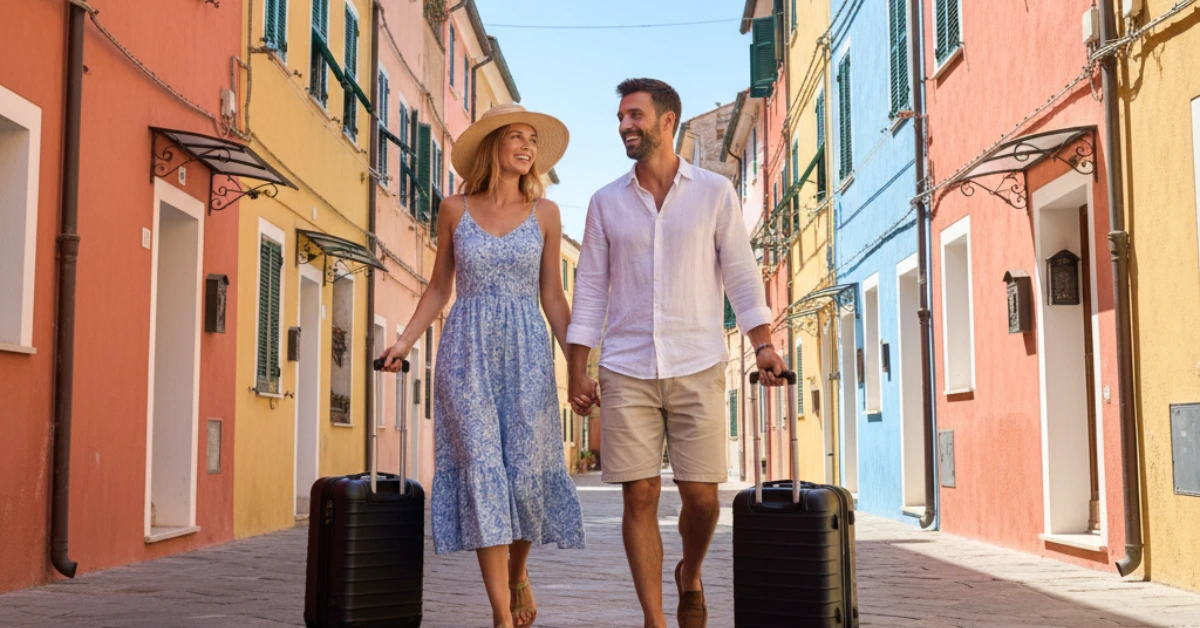Are you dreaming of swapping your Australian lifestyle for Italian piazzas and endless bowls of pasta? You’re not alone. Every year, thousands of Australians make the move to Italy, drawn by its rich culture, stunning landscapes, and surprisingly affordable cost of living. But moving to Italy from Australia involves more than just booking a flight. This guide will walk you through everything you need to know, from visas and documents to taxes and daily life in the European Union.
Table of Contents
ToggleFirst Things First: Which Visa Do You Need?
Before you can move to Italy, you’ll need the right visa. As an Australian citizen, you can visit Italy visa-free for up to 90 days, but living in Italy requires proper documentation. The visa you choose depends on why you’re moving and how long you plan to stay.
The Working Holiday Visa
If you’re between 18 and 30 and want to experience living in Italy while working to fund your travels, the Working Holiday Visa is your best bet. You’ll get 12 months to explore the country and take on short-term jobs. The catch? You’ll need to prove you have around €3,000 in savings, return airfare or equivalent funds, and health insurance. Keep in mind you can’t bring family members with you on this visa, and it’s designed for temporary stays rather than permanent relocation.
The Elective Residency Visa
Planning to retire in Italy or already have enough savings to support yourself? The Elective Residency Visa might be perfect for you. This visa is ideal if you want to live in Italy without working. You’ll need to show stable income of at least €31,000 per year, plus an additional €20,000 for each dependent. You’ll also need proof of accommodation and comprehensive health insurance. The trade-off is that you cannot work under this visa, making it suitable only for retirees or those with independent income streams.
Work Visas and Family Reunification
Got a job offer from an Italian employer? You can apply for a work visa, though your employer will need to sponsor you and demonstrate they couldn’t fill the position with someone from the European Union. If you have family already living in Italy, the Family Reunification Visa lets you join them. Your family member in Italy needs to apply for authorization first, then you can proceed with your own application.
| Visa Type | Duration | Best For | Min. Funds |
|---|---|---|---|
| Working Holiday | 12 months | Ages 18-30, travel & work | €3,000 |
| Elective Residency | Renewable annually | Retirees, no work allowed | €31,000/year |
| Work Visa | Contract length | Employment in Italy | Varies |
| Family Reunification | Renewable | Joining the family in Italy | Sponsor dependent |
What Documents Will You Need?
Getting your paperwork in order is crucial when moving to Italy from Australia. Missing even one document can delay your move by months. Here’s your essential checklist:
- Your passport (valid for at least 6 months beyond your planned stay)
- Complete visa application from the Italian consulate
- Health insurance proof (even though public healthcare exists through a Reciprocal Agreement, you’ll need private insurance for your visa)
- Police clearance certificate from Australia
- Proof of accommodation in Italy (rental contract or property deed)
- Recent bank statements showing that you can support yourself
- Birth certificate and marriage certificate, if applicable
Once you land in Italy, you have just eight days to apply for your Permesso di Soggiorno (residence permit). This is separate from your visa and essential for staying legally beyond your initial visa period. Don’t skip this step.
What Will It Cost You to Live in Italy?
Here’s some good news: living in Italy typically costs much less than living in major Australian cities. The average monthly cost of living hovers around €2,700–€2,800 per person, including rent. But the actual cost depends heavily on where you choose to settle.
How Costs Vary by City
If you’re eyeing Milan or Rome, expect higher costs. A one-bedroom apartment in Milan’s city center will run you €1,200–€1,500 monthly. Florence and Rome have similar price tags. But here’s where it gets interesting: smaller towns and southern regions are dramatically cheaper. In Naples, you’ll pay €700–€900 for a one-bedroom apartment. In rural Calabria or Abruzzo, you could find places for as little as €500–€600 per month, utilities included. The cost of living in these areas makes them attractive for those on tighter budgets.
Setting Up Your Bank Account
Opening a bank account in Italy is straightforward and essential for managing your finances. You’ll need your passport, proof of address, your residence card or employment contract, and your Codice Fiscale (more on that later). Italian banks offer different account types: Conto Corrente for everyday transactions, Conto di Risparmio for savings, and Conto di Deposito for higher-interest savings. Having a local bank account will save you from hefty international withdrawal fees and make paying rent and utilities much simpler.
Italian Taxes and Fiscal Benefits
Let’s talk about taxes, because this is where moving to Italy from Australia can get financially interesting. Italy offers some attractive fiscal benefits for newcomers, but you need to understand your obligations to avoid nasty surprises.
Your Essential Tax Number
Your Codice Fiscale is Italy’s tax identification number, and you’ll need it for absolutely everything. Want to rent an apartment? You’ll need it. Opening a bank account? You’ll need it. Signing up for utilities or accessing the healthcare system? You’ll need it. Get yours immediately when you arrive by visiting your local tax office (Agenzia delle Entrate) with your passport and proof of address. The good news is they’ll issue your number on the spot, with the official card arriving by mail later.
Your Tax Obligations as a Resident
If you spend more than 183 days per year in Italy, you’ll become an Italian tax resident and need to declare your worldwide income. Don’t panic though. Italy has a tax treaty with Australia to prevent double taxation, so you won’t pay twice on the same income. Even better, Italy offers special flat-rate tax regimes for new residents in certain situations. High-income individuals might be able to cap their tax on foreign income at €100,000–€200,000 annually, which can mean substantial savings. It’s worth consulting a tax professional who knows both Australian and Italian tax systems to maximize these benefits.
Healthcare System
Italy’s public healthcare system, known as Servizio Sanitario Nazionale (SSN), consistently ranks among the best in the world. As an Australian, you’re in luck. Australia has a Reciprocal Health Care Agreement with Italy, meaning you can access essential medical care in public hospitals and outpatient services just by showing your passport and Medicare card.
However, public healthcare doesn’t cover everything, and wait times can be long. Most expats purchase private health insurance for more comprehensive coverage, access to English-speaking doctors, and shorter wait times. Plus, private insurance is mandatory for most visa applications anyway. Expect to pay €50–€200 monthly, depending on your age and the coverage level you choose.

Finding Your Perfect Italian Home
Finding accommodation is one of your biggest tasks when moving to Italy from Australia. The rental market varies wildly depending on where you’re looking, with major cities commanding premium prices compared to smaller towns and coastal areas.
What You Need to Know About Renting
Here’s something that surprises many Australians: Italian leases typically run for a minimum of three years. There are temporary leases of 18 months available for non-residents, but breaking a lease early can be expensive. Many newcomers rent a room for six to twelve months first, giving themselves time to explore different neighborhoods before committing to a long-term lease. Use reputable websites like Immobiliare.it and Casa.it to search for properties. Always verify listings carefully, as rental scams do exist, especially in popular tourist cities.
Choosing the Right City to Live In
Where should you settle? Rome gives you incredible history and culture with a slightly lower cost of living than Milan. Florence offers stunning art and architecture plus a strong expat community. Milan is Italy’s financial powerhouse with the best job market but higher costs. Bologna combines affordability with world-class education and amazing food culture. If you’re dreaming of coastal living, Trieste offers safety, affordability, and gorgeous seaside views. Each city has its own personality, so choose based on what matters most to you.
Learning Italian
Yes, many Italians in major cities speak English. But if you want to truly integrate and get the most out of living in Italy, learning Italian is essential. Speaking Italian will dramatically improve your job prospects, help you navigate daily life more easily, and allow you to build genuine friendships with locals.
Language schools across Italy offer intensive courses ranging from €200–€800 per month. Many people find these classes double as excellent networking opportunities to meet other expats. Don’t worry if regional dialects throw you for a loop at first. Even fluent Italian speakers sometimes struggle with strong local accents. Give yourself time, practice regularly, and you’ll improve faster than you think.
Your Final Checklist Before Moving
As your departure date approaches, make sure you’ve handled these essential tasks. Cancel or suspend your Australian mobile phone plan, update your address with banks and government agencies, and arrange for mail forwarding. Make digital copies of all important documents and store them securely in the cloud. Book temporary accommodation for your first few weeks while you search for permanent housing.
Notify the Australian Taxation Office (ATO) of your departure and understand your tax obligations in both countries. If you own property in Australia, arrange for its management. Consider what to ship versus what to buy new in Italy, as shipping costs can be substantial. Finally, say proper goodbyes to friends and family, because while modern technology keeps us connected, moving to Italy from Australia is still a significant life change.
Would you like to read more about similar subjects? Take a look at our related articles here: Residence Permit for Cohabitation, Italian Golden Visa and Bring Pets to Italy.
Quiz: Moving to Italy from Australia
1. How long can Australians visit Italy without a visa?
30 days60 days
90 days
120 days
2. The Working Holiday Visa allows Australians aged between:
18–25 years18–30 years
21–35 years
25–40 years
3. What is the minimum amount of funds required for the Working Holiday Visa?
€1,000€2,000
€3,000
€5,000
4. The Elective Residency Visa is best suited for:
Students studying in ItalyRetirees with stable income
People seeking short-term work
Family members joining relatives
5. What is one document you must have when applying for an Italian visa?
A letter from your employerPolice clearance certificate
Italian language certificate
Car insurance
6. What is the average monthly cost of living in Italy per person?
€1,000–€1,500€2,700–€2,800
€3,500–€4,000
€5,000–€6,000
7. What is the Codice Fiscale used for?
Renting a carTax identification and official transactions
Registering for university
Getting a driver’s license
8. After how many days per year does an individual become a tax resident in Italy?
90 days120 days
183 days
200 days
9. Australians can access Italian public healthcare due to:
A bilateral visa agreementThe Reciprocal Health Care Agreement
EU residency rights
Private insurance requirement
10. Why is learning Italian important for newcomers?
It’s legally requiredIt helps with integration and job opportunities
It’s needed to get healthcare access
It shortens visa processing time



